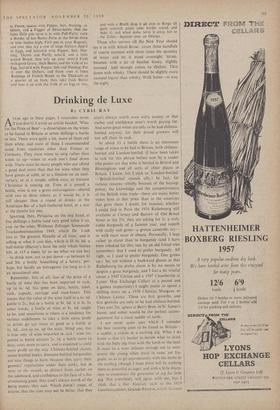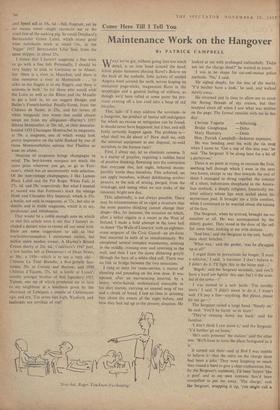Drinking de Luxe
By CYRIL RAY
AYEAR ago in these pages, I remember (even if you don't), I wrote an article headed, 'Wine for the Price of Beer' —a dissertation on the wines to be found in Britain at seven shillings a bottle or less. There were quite a lot, more of them red than white, and most of those 1 recommended came from countries other than France or Germany. They were wines to swig rather than wines to sip—wines to wash one's food down with. There must be many people who can afford a good deal more than that for wine when they have guests at table, or as a libation on an anni- versary, or as a simple, selfish treat, or because Christmas is coming up. Even at a pound a bottle, wine is not a gross extravagance—shared with two or three others, as it would be, it is still cheaper than a round of drinks in the American Bar of a half-timbered hotel, or a seat at the theatre for one.
Ignoring, then, Periquita on the one hand, at five shillings a bottle (and very good value it is), and, on the other, Wehlener Zeltinger Sonnenuhr Trockenbeerenauslese 1949, which Dr. Loeb lists as 'the greatest Moselle of all lime,' and is selling at what it cost him, which is £6 6s. 6d. a half-bottle (Harvey's have the only whole bottles left, at £15 a time), let us see what we can buy —to drink now, not to put down—at between £1 ' and 30s. a bottle. Something of a luxury, per- haps, but hardly an outrageous (so long as it is an occasional) one.
Remember, first of all, that of the price of a bottle of wine that has been imported in cask, up to 4s. 6d has gone on duty, bottle, label, cork, capsule, carriage and man-hours. This means that the value of the wine itself in.a 6s. 6d. bottle is 2s., but in a bottle at 8s. 6d. it is 4s. In other words, a bottle of wine at 8s. 6d. ought to be, and sometimes is (there is a tendency for various middlemen to take a little extra profit as prices go up) twice as good as a bottle at 6s. 6d., and so on, up the scale. Mind you, this is true only of wine imported in cask: wine im- ported in bottle attracts 2s. 5d. a bottle more in duty, costs more to carry, and is expeCted to yield more profit on the way. Chateau-bottled clarets, estate-bottled hocks, domaine-bottled burgundies are nice things to have, because they carry their growers' reputations under their corks, but in lave in the Mouth, as distinct from cachet on the sideboard, and confidence in the face of a dis- criminating guest, they aren't always worth all the extra money they cost. Which doesn't mean, of course, that the taste may not be better, that they aren't always worth some extra money, or that cachet and confidence aren't worth paying for. And some great wines are only to be had château- bottled anyway, for their proud growers will not sell them in cask.
At about £1 a bottle there is an enormous range of wines to be had in Britain, both chateau- bottled and London-bottled. (I have been taken to task for this phrase before now by a reader who-points out that wine is bottled in Bristol and Birmingham and all sorts of ,other places in Britain. I know, but I stick to 'London-bottled' —'British-bottled' sounds silly.) In fact, for various reasons—chiefly because of the buying- power, the knowledge and the competitiveness of the British wine trade—there arc many better wines here at that price than in the countries that grew them. I doubt, for instance, whether 1 could find in Paris the 1934 Richebourg still available at Corney and Barrow of Old Broad Street at the 25s. they are asking for it; a truly noble burgundy of a famouS year, and superb with really rich game—a grouse casserole; say— or with roast meat or cheese. Personally, I lean rather to claret than to burgundy (and I have been rebuked for this, too, by an old friend who remembers that I used to prefer burgundy. All right, so 1 used to prefer burgundy. One grows up.). So, not without a backward glance at that Richebourg (to prefer claret is by no means to despise a great burgundy, and I feel a bit wistful about a 1947 Corton and a 1947 Chamberlin at Lyons' Hop Exchange Cellars at a pound and a guinea respectively) 1 might prefer to spend a shilling more on a 1950 Chateau Margaux or Chateau Latour. These are first growths, and first growths are only to be had chateau-bottled. They cost 26s. apiece at Berry Bros. in St. James's Street, and either would be the perfect accom- paniment for a roast saddle of lamb.
I am never quite sure which I consider the best roasting joint to be found in Britain— a saddle, a sirloin or a sucking pig, What 1 do know is that it's harder to decide what to drink with the baby pig than with the lamb or the beef. It must he a wine delicate enough not to over- power the young white meat in taste, yet fra- graht, so as to go appropriately with the herbs in the stuffing (though 1 hope there will be nothing there as powerful as sage), and with a little sharp- ness to counteract the greasiness of my fat little pig. Not everybody will agree with me. but I think that a fine Alsatian, such as the 1955 Gewilrztraminer, Grande Reserve, which Saccone
and Speed sell at 19s. 6d.—full, fragrant, yet by no means sweet—might reconcile me to the cruel fate of the sucking pig. So could Deinhard's Berncasteler Green Label, which many good wine merchants stock at about 19s., or the 'bigger' 1957 Berncasteler Lilac Seal, from the same shipper, at about 25s.
I notice that 1 haven't suggested a fine wine to go with a fine fish. Personally, I should be
very happy to stick to Germany or to Alsace, but 'there is a river in Macedon; and there is also moreover a river at Monmouth . . . 'tis alike as my fingers is to my fingers, and there is salmons in both.' So for those who would wish the Loire as well as the Rhine and the Moselle to get a look in, let me suggest Hedges and Butler's French-bottled Pouilly-Fume, from the Chateau de Nozet, at 23s., and for lovers of white burgundy two wines that could almost tempt me from my allegiance—Harvey's 1955 Batard Montrachet, at 20s. 6d., or their domaine- bottled 1953 Chassagne Montrachet in magnums. at 50s. a magnum, one of which would look pretty impressive on the table flanked by one of those Monmouthshire salmon that Fluellen so went on about.
Mention of magnums brings champagne to mind. The best-known marques are much the same price wherever you go, so go to Fort- num's, which has an uncommonly wide selection. Of the non-vintage champagnes. I like Lanson Black Label and the Pol Roger White Foil, at 27s. 6d. and 28s. respectively. But what I wanted tc, record was that Fortnum's stock the vintage Moe and Chandon Dry Imperial. which is 35s. a bottle, not only in magnums, at 72s.. but also in double and in treble magnums, which is to say, jeroboams and rehoboams.
That would be a noble enough note on which to end this article were it not that I haven't in- cluded a dessert wine to round off our meal with.
Here are some suggestions to add to that irockenbeerenauslese I mentioned earlier, but within more modest means. A Harvey's Bristol Cream sherry at 26s. 6d.; Cockburn's 1947 port, a few bottles left at Downman's of Dean Street, at 30s.; a 1936—which is to say a very old— Chateau La Tour Blanche, a first-growth Sau- ternes, 20s. at Corney and Barrow; and. 1950 Chateau d'Yquem. 27s. 6d. a. bottle at Lyons'. worthy younger brother of that legendary 1921 Yquem, one sip of which prompted me to turn to my neighbour at a luncheon given by the chairman of Lebegues a couple of Christmases ago, and cry, 'I'm seven feet high, Wynford, and husbands are terrified of me!'







































































 Previous page
Previous page